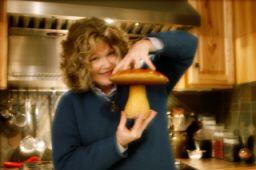Hi to all at this great website
My name is Jonty, and I am a college student too enamored with baking to waste time on my first ever blog on some other topic (ie: indie music, saving the world, angsty stuff).
To introduce myself to anyone who will read this (even if it is only ever me), I got into bread baking (I've been doing other types of baking with chemical leaveners for a while) from watching/reading a great anime/manga called Yakitate! Japan (of which I've found a couple of mentions on this site). I was inspired and eventually decided to give yeasted breads a try.
The first bread I ever tried was actually Erithid's Microwave Bread recipe that was inspired from Yakitate, and it turned out nicely (I'm still planning on trying to give it some filling in the future).
Then, I made the leap and made the Lesson 2 Bread, skipping Lesson 1 because I wanted a sandwich bread (of course, I ended up just eating the bread and not making any sandwiches. Such is life).
After, I made an even bigger jump and decided to try Bagels, using some freshly-bought KA Bread Flour. I made only a half-batch because of my tiny little cookie sheet. I ended up with three pretty good cinnamon-brown sugar bagels (though I think they could have used a bit more of each flavor addition) and three okay garlic-sesame bagels (I now know that bagels should probably be topped with already roasted garlic and not raw after having consumed a couple of fairly sour bagels). This will definitely be in my future again.
Presently, I have taken an even bigger leap to Floyd's ciabatta; it is now sitting on my kitchen counter on its final rise. I realize now that I may have had a little too much confidence as my dough ended up a bit lumpy (I think my autolyse was too dry). Also, I let my poolish sit for quite a while (something like 10-12 hours) because I got bored yesterday afternoon and decided to just make it. I'm not sure if letting a poolish ferment for that long is good or bad, but my dough kind of smells uncomfortably sour. We shall see, I suppose.
Future plans? I definitely want to give Pain Aux Raisins and Cream Cheese Snails a try, as well as Cranberry-Chocolate Sweet Buns, and Steamed Buns. Maybe I'll even try a challah or (gasp) my own sourdough starter? Well, sourdough is perhaps a bit far away from my reach, but I plan on being a diligent student for a while.








 Sourdough Proof
Sourdough Proof Sourdough Ciabatta #1
Sourdough Ciabatta #1 Simple Ciabatta: Baking of 4-11-07
Simple Ciabatta: Baking of 4-11-07 Whole Wheat Ciabatta
Whole Wheat Ciabatta
